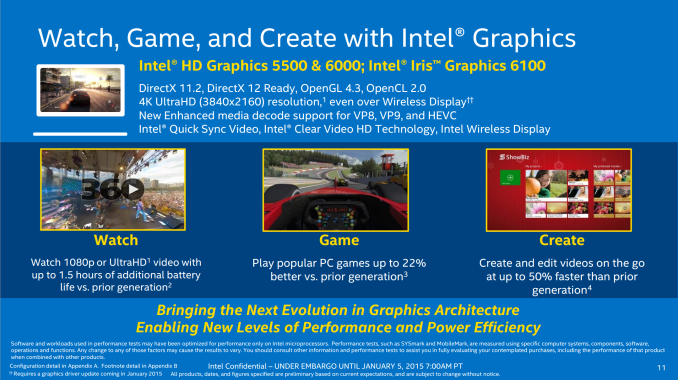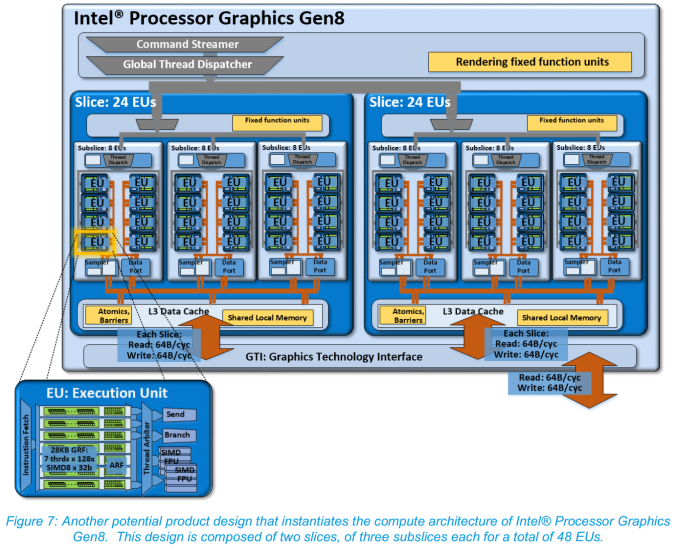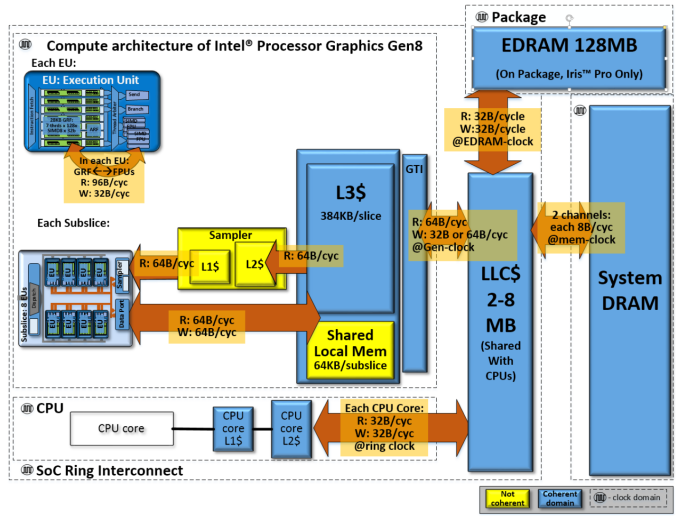Intel Releases Broadwell-U: New SKUs, up to 48 EUs and Iris 6100
by Ian Cutress on January 5, 2015 10:00 AM ESTBroadwell GPU Improvements
The new integrated graphics for Broadwell from Intel in the form of HD 5500, HD 6000 and Iris 6100 open up some very important functionality. DirectX 11.2, OpenGL 4.3 and OpenCL 2.0 are big scoring points, especially OpenCL 2.0 when it comes to graphics compute. This includes features such as shared memory coherency between CPU and GPU to allow transfer of pointer-rich memory structures and ultimately the beginnings of heterogeneous CPU + GPU compute.
‘DirectX 12 Ready’ is somewhat of an interesting case, and it depends on Microsoft’s final specifications. At this point in time Intel state that they conform to as much of DirectX 12 feature set that they can get their hands on with their relationship with Microsoft, and barring any major addition or change, should be compatible. UHD-4K is also now supported through the HDMI 1.4b interface, albeit limited to 24 Hz.
Support for HEVC is also present in terms of a combined (hybrid) hardware and software solution, just as it was on Core-M. Intel stated that as parts of the H.264 algorithm are near if not identical to those of the H.265, with a small tweak to the hardware it can be used for both. This is still not an all-encompassing hardware acceleration, but it does aim at some parts of the codec. I would speculate that if a full section of the silicon could be made for complete hardware acceleration, it might eat into certain power budgets.
GPU Slices
Although mentioned in our Broadwell architecture overview, for Broadwell-U we should cover the basics of the GPU layout. Below is an image of a HD 6000 implementation featuring two slices of 24 EUs each, with each slice having three sub-slices of 8 EUs. Each EU can handle 7 threads at once when in a 128xSIMD8 32-bit configuration. When in the right data structure, this offers a good amount of power, especially to coalesced 16-bit computation.
For Broadwell, Intel has reduced the number of EUs in a sub-slice from 10 down to 8. This is a big change, as it eases up the Thread Dispatch, Data Port and L1/L2 samplers in each EU as they have to deal with less data overall. By this logic, with two equivalent designs, one with 8 EUs per sub-slice should be able to get through more data due to less data bandwidth pressure and less competition for each sub-slice’s shared local memory.
Each slice has an L3 Data Cache, which for Gen8 is improved from 384 KB to 576 KB per slice. This ends up being split anyway as 64 KB per sub-slice as shared local memory and 384 KB for inter-slice L3 communication. More slices mean more caching overall, and as an aid to the last level cache outside the GPU, the Graphics Technology Interface has doubled the write bandwidth.
The principle behind caches is to provide a small amount of memory that can be accessed faster at the expense of size. The algorithms in place to predict which data is needed next (or preprogrammed data fetching) helps increase the overall speed of any CPU function, but increasing the size of a cache decreases the need for later caches by reducing the data misses that require trips further out. GPUs are historically bandwidth starved, both for gaming and for compute, so by virtue of having four named caches for the GPU to use and increasing at least the third, this should contribute to the large performance numbers Intel is producing in comparison to the previous generation.
In terms of throughput, Intel gives the following numbers for GT2 / 24 EU configurations:
32b FP: 384 FLOP/cycle = 24 EUs * (2 * SIMD-4 FPU) * (MUL + ADD)
64b DP: 96 FLOP/cycle = 24 EU * SIMD-4 FPU * (MUL + ADD) * 0.5 throughput
32b INT: 192 IOP/cycle = 24 EU * (2 * SIMD-4 FPU) * ADD
The Gen8 EUs will support 16-bit floats (half-floats) natively, as well as 16-bit integers.
We can construct a table calculating out to full performance:
| Intel Gen8 Graphics Throughput | |||
| Processor | 32b FP GFLOPs |
64b DP GFLOPS |
32b INT GFLOPs |
| i7-5557U (48 EUs at 1100 MHz) | 844.8 | 211.2 | 422.4 |
| i5-5257U (48 EUs at 1050 MHz) | 806.4 | 201.6 | 403.2 |
| i3-5157U (48 EUs at 1000 MHz) | 768 | 192 | 384 |
| i7-5250U (48 EUs at 950 MHz) | 729.6 | 182.4 | 364.8 |
| i7-5600U (24 EUs at 950 MHz) | 364.8 | 91.2 | 182.4 |
| i5-5300U (24 EUs a 900 MHz) | 345.6 | 86.4 | 172.8 |
| i3-5010U (23 EUs at 900 MHz) | 331.2 | 82.8 | 165.6 |
| i3-5005U (23 EUs at 850 MHz) | 312.8 | 78.2 | 156.4 |
| Pentium 3805U (12 EUs at 800 MHz) | 153.6 | 38.4 | 76.8 |
Having doubled the EUs not only doubles the performance but the extra bit of frequency also helps.
As we mentioned back in August, the sub-slice also gets some minor improvements to increase pixel and Z-fill rates, and the front end’s geometry units are also beefed up. Further reading can be found on Intel’s PDF on the Gen 8 Graphics Overview from IDF.













85 Comments
View All Comments
DigitalFreak - Monday, January 5, 2015 - link
They do, but it's not usually a major update.R3MF - Monday, January 5, 2015 - link
the 15W i5 chips will be the ones found in the vast majority of ultrabook models released by the vast majority of the ultrabook manufacturers.to me, the interesting question is whether the 48EU model will be popular, or whether the bulk of the above will be taken up by the 24EU models...?
will a Core i5-5300U** be sufficient to run Total War: Attila at low settings at 1600x900?
** 2 / 4 2.3 2.9 2.7 24 300/900 1600/1600 3MB 7.5W Yes $281
kspirit - Monday, January 5, 2015 - link
Well, my best bet is that the xx00 (24EU) parts will be the most popular just like Haswell ones were, because if I remember correctly these were the same prices for the equivalent Haswell parts. I only ever saw the 28W TDP parts in MacBook Pro and Zenbook Infinity, which are the very highest end ultrabooks. You're right when you say that i5 (and 24EU) parts will be the most common, and I don't think the performance increase will be noticeable at all...romrunning - Monday, January 5, 2015 - link
It used to be that you could generally equate an i7 with 4 cores. These i7 Broadwell-U CPUs all seem to be 2-core, so it just seems to muddy up the issue for the consumer. Oh well... maybe these were all meant for OEM designs anyway.drothgery - Monday, January 5, 2015 - link
Mobile i7s have been dual core from the very beginning. Real quad-core mobile parts didn't show up until the highest-wattage mobile Haswell parts ...RussianSensation - Monday, January 5, 2015 - link
What do you mean? There have been mobile quad-core HT i7s for 4 years now, with Sandy and Ivy:1. Core i7 2630QM - Jan 3, 2011
http://www.notebookcheck.net/Intel-Core-i7-2630QM-...
2. Core i7 3635QM - Sept 30, 2012
http://www.notebookcheck.net/Intel-Core-i7-3635QM-...
There have been many faster Sandy and Ivy quad-core i7s than the 2 models I specifically quoted. It is very misleading to call a dual-core HT CPU as an i7, when really that has always been an i3.
TiGr1982 - Monday, January 5, 2015 - link
Even earlier than that, for example, the first gen Nehalem (45 nm) Core i7-720QM was released in Q3 2009 and was a 4 core and 8 thread CPU:http://ark.intel.com/products/43122/Intel-Core-i7-...
However, these were 45 W parts; full wattage parts are a different story.
LukaP - Friday, February 20, 2015 - link
Those are all QM parts. Those have always been 4core. This article is about the Broadwell-U parts, which are made on a 2core die.drothgery - Monday, January 5, 2015 - link
Sorry. The QMs have been around for longer than I remembered, but dual core mobile i7s were around from the very beginning, and the quads have always been largely restricted to mobile workstation-type laptops and the occasional gaming laptop.psychobriggsy - Monday, January 5, 2015 - link
Very small dies, even for the 48 EU chip.Seems that the 48 EU chips will match the GPU performance, on paper, of AMD's Kaveri. This should allow for some interesting GPU comparisons in reviews.
The prices are not very pretty, and where are the quad-core chips? The cores are tiny on 14nm. Almost irrelevant. Modern CPUs are more like GPUs with CPUs tacked on.